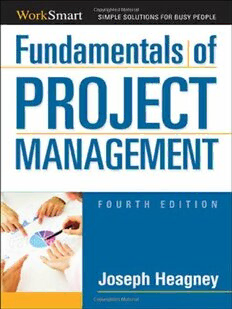Table Of ContentFundamentals of
Project Management
Fourth Edition
This page intentionally left blank
Fundamentals of
Project Management
Fourth Edition
JOSEPH HEAGNEY
American Management Association
New York • Atlanta • Brussels • Chicago • Mexico City • San Francisco
Shanghai • Tokyo • Toronto • Washington, D.C.
Special discounts on bulk quantities of AMACOM books are available
to corporations, professional associations, and other organizations.
For details, contact Special Sales Department, AMACOM, a division of
American Management Association, 1601 Broadway, New York, NY 10019.
Tel: 800–250–5308. Fax: 518–891–2372.
E-mail: specialsls@amanet.org
Website: www.amacombooks.org/go/specialsales
To view all AMACOM titles go to: www.amacombooks.org
This publication is designed to provide accurate and authoritative information in regard to the
subject matter covered. It is sold with the understanding that the publisher is not engaged in
rendering legal, accounting, or other professional service. If legal advice or other expert assis-
tance is required, the services of a competent professional person should be sought.
“PMI” and the PMI logo are service and trademarks of the Project Management Institute, Inc.
which are registered in the United States of America and other nations; “PMP” and the PMP
logo are certification marks of the Project Management Institute, Inc. which are registered in the
United States of America and other nations; “PMBOK”, “PM Network”, and “PMI Today” are
trademarks of the Project Management Institute, Inc. which are registered in the United States
of America and other nations; “. . . building professionalism in project management . . .” is a
trade and service mark of the Project Management Institute, Inc. which is registered in the
United States of America and other nations; and the Project Management Journal logo is a trade-
mark of the Project Management Institute, Inc.
PMI did not participate in the development of this publication and has not reviewed the content
for accuracy. PMI does not endorse or otherwise sponsor this publication and makes no warranty,
guarantee, or representation, expressed or implied, as to its accuracy or content. PMI does not
have any financial interest in this publication, and has not contributed any financial resources.
Additionally, PMI makes no warranty, guarantee, or representation, express or implied, that the
successful completion of any activity or program, or the use of any product or publication, de-
signed to prepare candidates for the PMP® Certification Examination, will result in the com-
pletion or satisfaction of any PMP® Certification eligibility requirement or standard.
Library of Congress Cataloging-in-Publication Data
Heagney, Joseph.
Fundamentals of project management / Joseph Heagney.—4th ed.
p. cm.
Includes bibliographical references and index.
ISBN-13: 978-0-8144-1748-5
ISBN-10: 0-8144-1748-5
1. Project management. I. Title.
HD69.P75L488 2011
658.4'04—dc22
2011012421
© 2012 American Management Association.
All rights reserved.
Printed in the United States of America.
This publication may not be reproduced, stored in a retrieval system,
or transmitted in whole or in part, in any form or by any means,
electronic, mechanical, photocopying, recording, or otherwise,
without the prior written permission of AMACOM, a division of
American Management Association, 1601 Broadway, New York, NY 10019.
Printing number
10 9 8 7 6 5 4 3 2 1
To the memory of Mackenzie Joseph Heagney,
sleeping with the angels.
This page intentionally left blank
CCOONNTTEENNTTSS
Figure List ix
Preface to the Fourth Edition xi
Acknowledgments xv
Chapter 1 An Overview of Project Management 1
Chapter 2 The Role of the Project Manager 24
Chapter 3 Planning the Project 32
Chapter 4 Developing a Mission, Vision, Goals,
and Objectives for the Project 45
Chapter 5 Creating the Project Risk Plan 55
Chapter 6 Using the Work Breakdown
Structure to Plan a Project 68
Chapter 7 Scheduling Project Work 81
Chapter 8 Producing a Workable Schedule 93
Chapter 9 Project Control and Evaluation 112
Chapter 10 The Change Control Process 125
Chapter 11 Project Control Using Earned
Value Analysis 141
Chapter 12 Managing the Project Team 156
Chapter 13 The Project Manager as Leader 168
Chapter 14 How to Make Project Management
Work in Your Company 180
Answers to Chapter Questions 185
Index 189
About the Authors 201
vii
This page intentionally left blank
FFIIGGUURREE LLIISSTT
1–1. Triangles showing the relationship between P, C, T, and S.
1–2. Life cycle of a troubled project.
1–3. Appropriate project life cycle.
1–4. The steps in managing a project.
3–1. Two pain curves in a project over time.
3–2. Planning is answering questions.
4–1. Chevron showing mission, vision, and problem statement.
4–2. Risk analysis example.
5–1. Risk matrix.
5–2. Risk register.
6–1. WBS diagram to clean a room.
6–2. WBS level names.
6–3. Partial WBS.
6–4. Responsibility chart.
7–1. Bar chart.
7–2. Arrow diagrams.
7–3. WBS to do yard project.
7–4. CPM diagram for yard project.
7–5. WBS to clean room.
8–1. Network to illustrate computation methods.
8–2. Diagram with EF times filled in.
8–3. Diagram showing critical path.
ix

